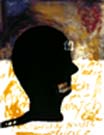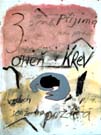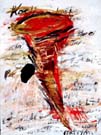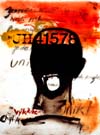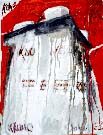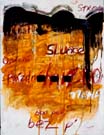Cerny Hlava is a continuing series of work that has been inspired from a recent trip
to Prague and Vienna. Cerny Hlava is derived from the Czech language, literally
translated to mean Black Head. This series of artwork is a fusion of materials and
processes, consisting of lithography, drypoint etching, oil paint, oil crayon and
collage on mylar. It contains a combination of words, numbers and visual forms.
There is also a synthesis of less tangible means that of the personal and the
historical, and of memory. It is this content that provides the inspiration for Cerny
Hlava / Black Head Series.
The first day exploring in Vienna brought me to a park situated by a lovely
neighborhood of grand buildings. It is within the park that I came upon two huge,
menacing buildings. These formidable structures appeared to have been built and used
as armaments for WWII. They were constructed of gray bricks towering to two hundred
feet in the air with several half moon parapets used to support anti-aircraft guns.
Faded German words remained on the buildings: Hur ewehrmaeht, MUTTERuKIND, JangHOR,
Bereithalten. The thought of what these structures represented and the atrocities the
war perpetuated disturbed me greatly. These buildings felt evil and haunted and it is
this powerful, unsettling memory that I brought back with me to inspire this series.
Cerny Hlava / Black Head Series is about the pain and suffering of the victims of World
War II. Each of these heads is black, anonymous and screaming a beseeching wail of
oneıs tormented soul. For example, the collaged numbers in the head cavity talks
about the degradation and serialization of the victims. Like a tattoo, it becomes a
physical imprint within the skin and hints of the horrors suffered. The surrounding
color is raw and tense and the Czech word for scream -- VYKRIKY is highlighted in
red.
The Czech language also had a profound influence on me. There is a visual strength to
the words with its inherent marks and lettering. The language, just like the
antiquated buildings and cobblestone squares, remains the same as before the Velvet
Revolution and before World War II. Perhaps itıs because they have survived such
tumultuous histories that they breathe, whisper and sometimes scream of the injustices
and inhumanities that they have witnessed. And in being there, in a certain place in
historyıs memory, that one carries away with them an infusion of knowledge and
insight.
Go to the Dean's Gallery home page
|
||
